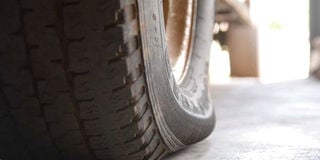Why your tyres are wearing out fast

When a tyre is carrying less pressure than it was designed to carry, it will have to bear the weight of the car and the load it is carrying with the available pressure.
What you need to know:
- Brand new tyres can last for between three to five years without need for replacement. However, this is dependent on how and where you drive.
When well taken care of, brand new tyres can last for between three to five years without need for replacement. However, this is dependent on how and where you drive.
Low or high pressure
Jimmy Ssebadduka, a tyre technician, observes that a number of the clients who report with tyre problems are mainly those whose tyres have worn out unevenly. When you closely look at some tyres, it is usually evident that either the outer tread area is more worn out than the inner one or vice versa. While this could be blamed on under inflation, you could also attribute it to negotiating corners at high speeds.
“When a tyre is carrying less pressure than it was designed to carry, it will have to bear the weight of the car and the load it is carrying with the available pressure. This way, it will wear out faster,” Ssebadduka advises.
Similarly, if, for instance your tyres were manufactured to carry, say, 30 pounds per square inch (PSI), and you exceed to 40 PSI, you would have over inflated your tyres. PSI are the units used to measure tyre pressure.
“When you over inflate your tyres, the central treads (the middle of the tyre) will maintain contact with the road surface. Over time, they will wear faster and unevenly since the treads will not be balanced to touch and maintain contact with the road,” Ssebadduka explains.
Under and over inflation
According to Tyrebuyer.com, an under-inflated tyre will flex more when cornering and stopping. Under-inflated tyres do not respond as quickly as they would if they were properly inflated, so you lose some of the performance and safety benefits built into the tyre by the manufacturer.

Driving a vehicle with unbalanced tyres is unsafe and can cause serious damage to your car. PHOTO/David Lubowa
The portal adds that over-inflated tyres can lose traction because the shape of the tyre actually becomes deformed by excessive air pressure, decreasing its footprint on the road. “Over-inflated tyres can be more prone to damage since an over-inflated tyre is stiffer and may not react as expected to common road hazards such as potholes. Also, over-inflation could make your vehicle a harsh, noisy ride,” the portal says.
Negotiating corners at high speeds
The stability of your car could have the capability to negotiate a corner, for example at 80km/hour. Much as you could enjoy the moment, your tyres unknowingly bear the consequences.
“The treads on the outer area will wear out faster than those on the interior because they (outer treads) will be used to maintain a high level of traction to keep the car on the road,” says Peter Kasoma, a tyre technician. At high speeds, especially when negotiating corners, he adds, some types with low stability levels tend to skid off the road.
Harsh braking
When you harshly brake, say to avoid knocking other road users, Kasoma notes that this kick starts the process of your tyres, partially wearing out. When you brake harshly, one side of the tyres will rub against the road surface and the other will not. There will also be visible tyre marks on the road surface, explaining that a part of the tyre has been eaten up by the solid road surface.
Poor car alignment
Recently, Ambrose Mugisha visited a garage to carry out a wheel alignment. Unknowingly, he had driven over a stone causing one of his front tyres to lose a balanced grip with the road surface, a discomfort he could feel through the steering wheel.

Car tyre
Kasoma says one of the quickest ways to tell that your tyres are not properly aligned is to take your hands off the steering wheel when driving, especially at straight stretches. A car with poor alignment, he says, will tend to veer off the road.
Replacing car tyres is costly, with a single brand new piece sometimes costing between Shs150,000 for saloon cars, to as high as Shs1m or more for sport utility vehicles (SUVs) or pickups. To avoid incurring such cost, observe these and many more tyre preservations measures.




